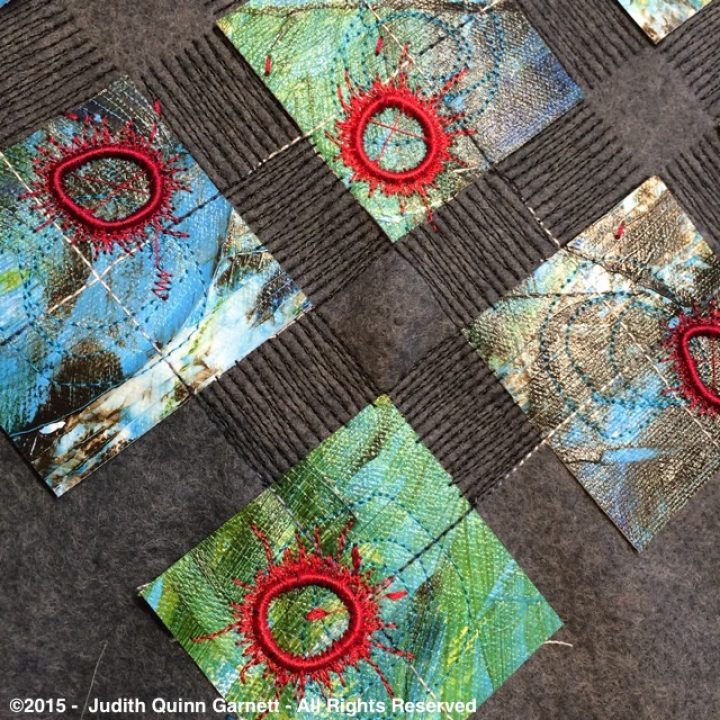
“Business as Usual” Marketing Fails Another Innovative Product: Titanium Coated Sewing Needles

Product innovation is the lifeblood of consumer hardgoods companies. And I’ve spent my career using communication to get maximum business impact for innovative products.
So when I hear of an innovation that underperforms in the market because it’s misunderstood my ears always prick up — like when my wife told me about titanium needles for her sewing machine.
Titanium Coated Needles. My wife, Judith Quinn Garnett, is a painter and creates innovative work that starts with acrylic paint on canvas which is embellished with stitch, found objects, and post consumer waste. Her use of a sewing machine has to deal with stitching acrylic painted canvas, sometime layered, and backed with felt. This odd match of materials makes for a pretty amazing end result and a major challenge for a sewing machine.
She recently heard an experienced quilter observe: “Titanium Needles? You should never, ever use them because they’re so hard they can bind and break your machine.” (The funny thing? This woman had never used these needles. But beyond a few enthusiasts you’ll find her opinion widely shared.)
Eventually Judith picked up some titanium needles and tried them out. And? She loved them. Absolutely loved them.
In her work traditional needles wear out quickly and while sewing with them her machine thrums and shakes the table. But she found that titanium coated needles moved through fabric easier and more smoothly than an ordinary needle and stayed sharp longer which should reduce the wear and tear on her machine. Quite a compelling experience.
It’s No Surprise, Though, That Innovation Like This Suffers Weak Market Performance. With benefits like these, this outstanding and highly useful product should have flown off the shelf making consumers happy while driving excellent profits and high margins.
Instead, these needles languish on the shelves. When I recently visited a retail sewing machine shop, I found they stocked one SKU of TiN coated sewing needles out of probably 300 to 400 needle SKUs. And the very knowledgable associate who helped me had no idea why they would be good – so he wouldn’t have ever been likely to recommend them.
“Business as Usual” Marketing Fails Innovation. I don’t know how the first needles of this type were introduced. In most marketing situations that I’ve run into where an innovative product with outstanding benefits doesn’t sell the failure is usually a marketing failure.
What else could it be? Someone did outstanding work to develop the idea, test it out, and start up manufacturing. (I’ll guess that manufacturing wasn’t exactly easy.)
My experience is that after all this innovation, the product is turned over to “business as usual” marketing. So the needles were sold into the retail channel. Once they were put on the shelf some information about them was put up on the website and they were probably taken to trade shows. And, sales were lackluster.
Let me note that in these days of tremendous digital hype it has become “business as usual” to try out some of the shiny digital baubles thinking that will help. But 999 times out of 1000 these baubles are a big distraction that doesn’t help innovative products. Innovative products require highly compelling communication delivered regularly in high visibility media. It’s not going to create demand to get an innovative product on the shelf then put out some Facebook posts or hope a video goes viral.
You Have to Help Consumers “Understand” What It Took Your Engineers Months and Years to Understand. Companies work hard and invest a lot of money discovering innovations then bringing them to market. Then they seem to forget that if the product is truly innovative, it will only leap off the shelf when consumers understand it.
When an innovation isn’t understood consumers fill in the gaps on their own – and leap to all the wrong conclusions. In this case they assumed the needles were made of titanium metal so they might be too strong and could break an expensive sewing machine.
The understanding that was missing is that these aren’t titanium needles. They are titanium nitride coated needles. Titanium nitride is a durable hard ceramic coating that reduces friction. Products with this coating are sometimes referred to as “TiN Coated” and TiN is well known for industrial uses.
You can check out this list of benefits on the Superior Threads website (link here). It’s a great list – although the claims would support the erroneous conclusion that the needles are made from titanium. It’s also a bit ironic that the needles are probably less likely to bind since they move through fabric better.
The Innovation Bottom Line: When you make a truly innovative product, you should expect more from it. Innovation should build your brand, sell well immediately, and return excellent numbers on the bottom line. But you’ll never get there when you pair business as usual marketing with an innovative product.
Copyright 2016 – Doug Garnett – All Rights Reserved
Categories: consumer marketing, Innovation, Retail
